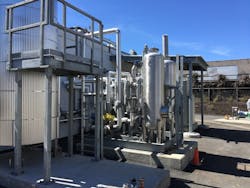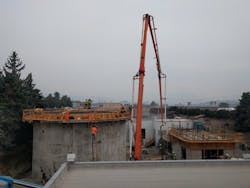About the author:
Cristina Tuser is associate editor for WWD. Tuser can be reached at [email protected]
Located in The Dalles, Oregon, Dalles Wastewater Treatment Plant (WWTP) discharges to the Columbia River, the nation’s second largest river.
The city cleans about 2 million gallons of water per day (mgd) before it is discharged into the Columbia River. The plant only has seven certified operators, and the sewer lines are maintained by nine certified operators. Fats, oils and grease (FOG) are the second biggest cause of sewer backups in The Dalles.
The Dalles WWTP serves a population of 15,100 residents and processes 7.7 mgd of daily peak wet weather wastewater flows, which was made possible after The Dalles WWTP Progressive Design-Build Phase 2 upgrades. This project was initiated in 2015 as a means to upgrade the treatment plant.
According to Kennedy/Jenks Consultants Inc., in 2013, existing and future needs at the plant included: influent pumping capacity deficiencies; a lack of reliability in the headworks process; and a need for greater anaerobic digestion capacity.
In 2015, The Dalles embarked on a Progressive Design-Build (PDB) project delivery method to plan, design and construct upgrades at the plant. The city, the contractor Mortenson Construction and the design engineer, Kennedy/Jenks Consultants, collaborated for the project. This is also the first PDB project embarked on by a municipality for a major WWTP upgrade in the state of Oregon.
“Part of our value is being early in the process, helping the engineer with constructability,” said Tom Paul, general manager of Mortenson Construction. The State Revolving Fund was used to fund the project. “We built new headworks, capturing inorganic materials for us to wash and send to landfills. We also put in an anaerobic digester, but one of the byproducts of it is natural gas, or methane.”
In January of 2016, Mortenson Construction and Kennedy/Jenks were awarded $9 million for the project. Oregon’s Department of Environmental Quality (DEQ) requires plants to have firm capacity for its influent system. The plant, which is over 70 years old, did not have that firm capacity.
The project provided for the design and construction of a new influent pump station; plant headworks facility; conversion of an existing 180,000 gallon biosolids storage vessel into an anaerobic digester with fixed roof; and aesthetic improvements to the treatment facility.
The plant provides secondary treatment and ultraviolet (UV) disinfection followed by discharge to the Columbia River. Current dry weather flows range from 2.3 to 4.15 mgd with a current peak instantaneous flow (PIF) of 7.4 mgd. PIF flows are projected to be 10.8 mgd in 2022, 11.9 mgd in 2030, and 13.2 mgd at buildout.
Among the upgrades were improvements to the solids storage system, with the construction of a digester. This allowed the city to accommodate outside waste streams and maximize renewable energy with a newly constructed cogeneration facility.
The Dalles WWTP is the first plant in Oregon to install a primary filtration facility to divert solids directly for conversion to renewable power. These upgrades tend to lower operating costs, ultimately minimizing resource consumption.
The upgrades have also increased plant capacity from a peak flow rating of 7.7 mgd to 13.2 mgd, which is the projected capacity for 2037.
Upgrades were designed with size, aesthetics and odor control in consideration.
Mid–Columbia Economic Development District (MCEDD) has supported the city in management of labor standards for the project to ensure compliance with state and federal regulations during the construction since January 2017. After four years of planning, design and construction, the project was completed in 2019.
The project was constructed for less than the initial project budget, under a compressed schedule due to the PDB delivery model. Ultimately the project savings allowed The Dalles to make additional improvements outside of the original scope of work.
Dave Anderson, director of Public Works, went to the city board and got it to waive the competitive bid statute, according to Paul.
“In the state of Oregon, the State Revolving Fund, at the time, did not recognize progressive design build as an acceptable procurement method,” Paul said. “With some hard work, Dave and the team got the state to understand that this was a good procurement method.”


